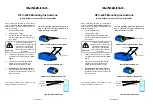
The Federal Clean Air Act Amendments of 1990 requires that all
vehicles sold in the United States meet OBD-II requirements by the
1996 model year. The first OBD-II systems appeared on selected
vehicle types in 1994.
Some important OBD-II requirements are: Vehicle service
information available to all technicians; Standardization of Terms:
Use of SAE J-1930 recommended terms; OBD-II requires a
common Diagnostic Link Connector (DLC) and specifies its location
in the vehicle; Generic scan tool; Generic emission related
Diagnostic Trouble Codes (DTC); and a very specific Malfunction
Indicator Light (MIL) illumination protocol.
One very important part of the OBD-II requirements is that
technical service information for emissions related components and
systems, which could affect the vehicle's emission levels, will be
available to all technicians; not just OEM dealership technicians.
This will allow all technicians to better understand how the systems
recognize faults and set the DTCs. The technician can now make a
repair and verify the repair by exactly duplicating the criteria that is
required for the DTC to be set.
What is CAN (Controller Area Network)?
CAN (Controller Area Network) is the newest computer protocol in
the automotive industry. It is being rolled out in Ford, GM, Mazda
and SAAB, current model year cars and is mandatory on all cars by
2008. Computerization of vehicles has shifted from one computer
controlling everything to a distributed system consisting of many
computers, each having its own area of responsibility. This raises
the challenge of how to make all of the computers communicate with
each other in order to share the work they do. The solution is CAN-
the protocol that allows the manufacturers to implement fast, effi-
cient, interoperable computers.
Page 90
T
ECHNICAL
D
ESCRIPTION OF
OBD-I, OBD-II
AND
CAN
Summary of Contents for EX-SCAN 5000
Page 1: ...USERS MANUAL...
Page 95: ...NOTES Page 95...
Page 96: ...NOTES Page 96...
Page 97: ...NOTES Page 97...








































